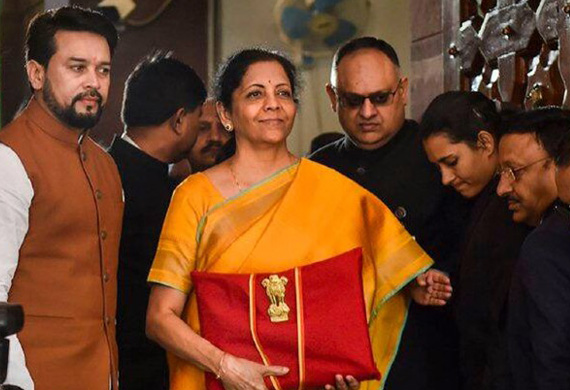
Women workforce participation: Will it witness growth?
By: Anindita, writer
With the announcement of urban capacity building, the union budget 2022 presented in the parliament by Nirmala Sitharaman, Honorable Minister of Finance, Government of India provides a huge fillip to Labor Force Participation of Women. In Urban India at present, overall, the women's workforce participation rate is at 20.3 per cent to 18.2 per cent. Compared to 41.25 per cent in 2021 as per the statistics available, women's employability is at 51.44 per cent for 2022. Over the last three decades, the Female Labor Force Participation Rate (FLFPR) has continued to fall.
"As per Governmental data, both the industrial sector & the services sector have recorded an increase in GVA (Gross Value Added). In Q1 of FY 2021-22 (The industrial sector's GVA grew by 67 per cent and the services sector's GVA grew by 18 per cent during this time frame). There are over 1.84 Crores of women in urban India who are currently employed. As per the data put together by Avtar, employable and available women talent is likely to surge to 7.4 Crores in 2022. Close to 3.8 lakh companies are expected to offer remote work in 2022 (this is almost double the number of companies offering the same in 2016). The Budget announcements are a leg-up to include a larger pool of talent to participate in the country's GDP," said Dr Saundarya Rajesh, Founder- President of Avtar Group. Benefitting women predominantly with a boost to the MSME sector and a focus on formalizing it, Union Budget 2022 has set the tone for a massive push to create more jobs.
Robust growth:
Compared to 21.9 per cent one-year prior in March 2021 the PLFS Quarterly 2021 reported that the female labour force participation rate (FLFPR) had dropped to 21.2 per cent. From 10.6 per cent the year before the female unemployment rate increased to 11.8 per cent in March 2021 during the same period. As per the Economic Survey for the year 2022-2023, the economy has begun to look up with a forecast of robust growth of 8 to 8.5per cent. 6 million new jobs will also be created by the pandemic led momentum for MakeInIndia that stressed Atmanirbhar Bharat. Women's workforce participation will also be boosted by the MSME, a key sector. 40 per cent of exports and 30 per cent of GDP is comprised by the sector out of the total 45 per cent of the manufacturing output.
Dr Saundarya Rajesh further adds, "Micro and small enterprises have got a lot of attention in the latest budget and through skilling, the employability, especially of women, gets an impetus. Alongside the mammoth push for MSMEs, another encouraging initiative is the focus on tier-2 and tier 3 to make them centres of sustainable living. This is a big step and can push women's workforce participation, as it would open up opportunities for them closer to home." "We foresee more than 3.9 lakh companies to be invested in upskilling. An upskilled workforce will further boost the country's GDP that is being predicted to grow at 8.5 per cent GDP in this year 2022-23," added Dr Saundarya.
Employment of Women in Rural Areas:
The Finance Minister has remained rigidly tied to A long-term view of ‘India at 100’ that remains centred around enhancing capital expenditure-supported ‘growth’ and ‘productivity’ in big-infra segments. While adversely affecting the female labour force participation rate in these segments, from a gendered analysis of past-employment trends across sectors, most jobs created in areas of infrastructure (including construction, ports, logistics) have broadly increased male participation. Women employment viz-a-viz males have been in some proportion in areas of services, communication, part-manufacturing and agri-business.
Targeted at women-centred development Union Finance Minister Nirmal Sitharaman did announce a slew of initiatives in her fourth budget speech. “Recognising the importance of 'Nari Shakti', three schemes were launched to provide integrated development for women and children," the FM said in Parliament today. Sitharaman said Mission Poshan 2.0, Mission Vatsalya and Mission Shakti were launched recently to provide integrated benefits to children. Two lakh anganwadis will be upgraded under the scheme, Sitharaman added.
To address the ‘joblessness’ crisis head-on Higher allocations to MGNREGA (already affected in 2021 by inadequate budgets), greater support to states for targeted job creation, enhancing PLI schemes towards ‘job creation’, and introducing an urban version of the MGNREGA plan were all seen as part of expectations. Between the unorganised-organised space, India’s broken labour markets and an asymmetric employment landscape has largely been split. In the vulnerable unorganised, informal space most women in India’s employment landscape are employed. As per the 2017-18 PLFS data (not considering the pandemic effect), India’s female labour force participation rate (LFPR) – the share of working-age women who report either being employed or being available for work – is as low as 16.4 per cent (in the 15-29 age group) and 33 per cent (in the 35-39 age group).






